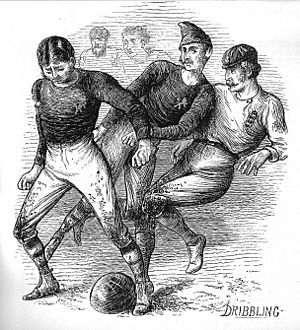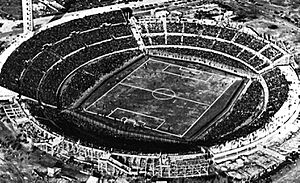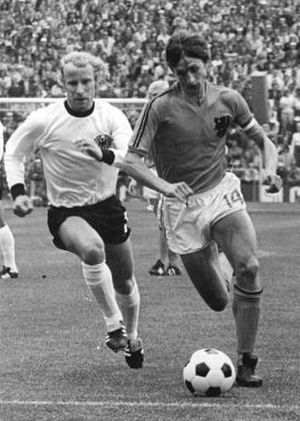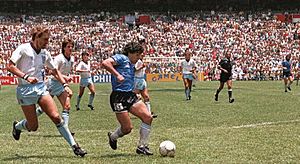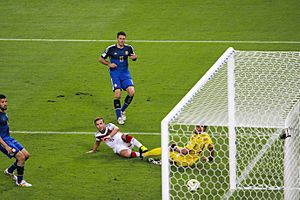History of the FIFA World Cup facts for kids
The FIFA World Cup is a huge international football tournament for men's national teams. It was first held in 1930. This happened because FIFA, the world's football governing body, decided to create a global competition. The idea came from FIFA president Jules Rimet, who led FIFA from 1921 to 1954. He was so important that the trophy was even named the Jules Rimet Cup for a while!
The first World Cup in 1930 had only 13 teams, who were invited to play. Since then, the tournament has grown a lot. Now, over 200 teams from all over the world try to qualify over two years. Only 48 teams make it to the final tournament.
Contents
Football Before the World Cup (Before 1930)
The very first official international football match was played in 1872. It was in Glasgow, Scotland, between the Scottish and English teams. Back then, football wasn't played much outside Great Britain.
By the late 1800s, some games were called "football world championships." These were usually matches between top English and Scottish clubs. For example, in 1895, Sunderland A.F.C. beat Heart of Midlothian F.C.
In the 1900s, football became popular worldwide. Many national football groups were started. The first official international match outside the UK was in 1902. It was between Uruguay and Argentina in Montevideo.
FIFA (Fédération Internationale de Football Association) was founded in Paris on May 22, 1904. It included teams from France, Belgium, Denmark, the Netherlands, Spain, Sweden, and Switzerland. Germany also promised to join.
As football grew, it became an Olympic sport. It was played at the 1900 Summer Olympics and 1904 Summer Olympics. Then, it became an official FIFA-supervised Olympic event at the 1908 Summer Olympics. These early Olympic football events were only for amateur players. England's amateur team won in both 1908 and 1912.
FIFA tried to organize its own international tournament in 1906 in Switzerland. But it wasn't very successful.
Since the Olympics only allowed amateur teams, competitions for professional teams began. The Sir Thomas Lipton Trophy in 1909 was one of these. It's sometimes called "The First World Cup."
In 1914, FIFA agreed to recognize the Olympic tournament. They called it a "world football championship for amateurs." This led to the first intercontinental football competition at the 1920 Summer Olympics. Belgium won it. Uruguay then won the tournaments in 1924 and 1928.
The World Cup Begins (1930s)
In 1930, FIFA decided to create its own international tournament. The 1932 Summer Olympics in Los Angeles didn't plan to include football. This was because football wasn't very popular in the United States. Also, FIFA and the Olympic Committee disagreed about amateur players. So, football was removed from the Olympics.
FIFA president Jules Rimet then organized the first World Cup. Uruguay had won the last two Olympic football tournaments. They were also celebrating 100 years of independence in 1930. So, FIFA chose Uruguay to host the first World Cup.
Teams from different countries were invited. But traveling to Uruguay was a long and expensive trip across the Atlantic Ocean. This was especially hard during the Great Depression, a time when money was scarce. For a while, no European country wanted to send a team. Finally, Jules Rimet convinced teams from Belgium, France, Romania, Hungary, and Yugoslavia to go. In total, 13 nations played: seven from South America, four from Europe, and two from North America.
The first two World Cup matches happened at the same time. France beat Mexico 4–1, and the United States beat Belgium 3–0. Lucien Laurent of France scored the first goal in World Cup history. Four days later, Bert Patenaude of the U.S. scored the first World Cup hat-trick (three goals in one game). This was in their 3–0 win against Paraguay.
In the final match, Uruguay beat Argentina 4–2. About 93,000 people watched in Montevideo. Uruguay became the first nation to win a World Cup!
The 1934 World Cup was held in Italy. This was the first time teams had to play qualifying matches to get into the tournament. Sixteen teams qualified. Uruguay, who won in 1930, didn't play in 1934. They were still upset that so few European teams came to their World Cup in 1930. Bolivia and Paraguay also didn't play. This meant Argentina and Brazil went straight to the finals without playing any qualifying games. Egypt was the first African team to compete, but they lost in the first round. Italy won the tournament, becoming the first European team to win the World Cup.
The 1938 World Cup was also held in Europe, in France. Many South American teams were unhappy about this. Uruguay and Argentina didn't play. For the first time, the team that won the last World Cup and the host country automatically qualified. Austria had qualified, but due to political changes, their team withdrew. Some Austrian players joined the German team. England was offered Austria's spot but said no. So, 15 nations competed. France hosted, but Italy won the tournament again, beating Hungary in the final. This was the first time the host country didn't win.
World Cup Pause (1940s)
| Country | Result |
|---|---|
| Cancelled | |
The FIFA World Cup was supposed to happen in 1942. Germany and Brazil both wanted to host it. But then World War II started in Europe in 1939. Because of the war, plans for the 1942 World Cup were cancelled before a host country was even chosen.
During the war, FIFA had very little money or staff. So, they couldn't plan a tournament for when the war ended. When the war finished in 1945, it was clear FIFA couldn't organize a 1946 World Cup in just one year. FIFA's first meeting after the war was in July 1946, around the time the 1946 World Cup would have been played. They tried to plan the next World Cup for 1949, but no country would host it.
After the War (1950s-1970s)
1950s
Competitions started again with the 1950 World Cup in Brazil. This was the first time British teams played. British teams had left FIFA in 1920, partly because they didn't want to play against countries they had fought in the war. They rejoined in 1946. England didn't do well in 1950. They lost 1–0 to the United States, which was a big surprise.
The 1930 champions, Uruguay, also returned after not playing in the previous two World Cups. Some Eastern European countries like Hungary and the Soviet Union didn't enter for political reasons. Italy, the defending champions, played even though many of their national team players had died in a tragic plane crash in 1949.
The 1950 World Cup was unique because it didn't have a final knockout match. Instead, the winner was decided by a final group stage. The last match of this group, between Uruguay and Brazil, is sometimes called a "final." Uruguay surprisingly beat hosts Brazil 2–1. This game, known as the Maracanazo, made Uruguay champions for the second time. It also set a record for the highest attendance at a sporting match, with about 200,000 people!
The 1954 World Cup in Switzerland was the first to be shown on TV. Scotland played for the first time but didn't win any games. This tournament had many goals. West Germany won, beating Hungary 3–2 in the final. They came back after being down 2–0. This match is famous in Germany as the Miracle of Bern.
Brazil won the 1958 World Cup in Sweden. They were the first team to win a World Cup outside their home continent. All four British teams qualified for the first time. The tournament also saw the rise of Pelé, a young Brazilian star, who scored two goals in the final.
1960s
Chile hosted the 1962 World Cup. Two years before, a huge earthquake hit Chile, causing a lot of damage. Officials had to rebuild much of the infrastructure. During the tournament, some top players like Pelé got injured. The competition also had some very rough and defensive play. This led to a famous match called the Battle of Santiago between Italy and Chile. Players on both sides tried to hurt opponents. Two Italian players were sent off, and the Italian team needed police protection to leave the field.
In the end, Brazil beat Czechoslovakia 3–1 in the final. They won their second World Cup in a row and kept the Jules Rimet trophy. In another match, Marcos Coll of Colombia scored a goal directly from a corner kick. This is the only time that has happened in a World Cup!
The 1966 World Cup was in England. It was the first to have a mascot and an official logo. The trophy was stolen before the tournament but was found a week later by a dog named "Pickles." South Africa was banned from the tournament due to its apartheid policies. This ban lasted until 1992. African nations also protested in the qualifying rounds because they felt they weren't given enough spots. North Korea became the first Asian team to reach the quarter-finals, beating Italy along the way. England won the tournament. Geoff Hurst scored the first hat-trick in a World Cup Final.
1970s
The 1970 World Cup was held in Mexico. The qualifying stages were affected by a conflict between Honduras and El Salvador. The tournament is remembered for a great save by England goalkeeper Gordon Banks from a Pelé header. It's also famous for the semi-final between Italy and West Germany. Five goals were scored in extra time, and Franz Beckenbauer played with a broken arm. Italy won 4–3 but lost 4–1 in the final to Brazil. Brazil became the first nation to win three World Cups and got to keep the Jules Rimet trophy forever.
A new trophy was made for the 1974 World Cup in West Germany. East Germany, Haiti, Australia, and Zaire played in the finals for the first time. The tournament had a new format with two group stages. The West German hosts won, beating the Netherlands 2–1 in the final. The Netherlands' "Total Football" style of play impressed everyone.
The 1978 World Cup was in Argentina. There were some concerns because of political changes in the country. But all the teams decided to play. This was the hardest World Cup to qualify for, with many countries competing for few spots. Iran and Tunisia played for the first time. Tunisia became the first African team to win a World Cup game, beating Mexico 3–1. In the second round, Argentina needed to win by a large margin against Peru to reach the final. They won 6–0, leading to rumors about the match. Argentina then won the final 3–1, with the Netherlands finishing as runners-up again.
Late 20th Century (1980s-1990s)
1980s
Spain hosted an expanded 1982 World Cup with 24 teams. This was the first expansion since 1934. Cameroon, Algeria, Honduras, New Zealand, and Kuwait made their first appearances. In a match between Kuwait and France, the Kuwaiti team stopped playing after hearing a whistle from the stands. They thought it was the referee's whistle. A French player scored, and the Kuwaiti team protested. The president of the Kuwait Football Association even ran onto the field! The referee then disallowed the goal. France still won 4–1.
Also in the group stage, Hungary beat El Salvador 10–1. This is still the only time a team has scored ten goals in a World Cup match. A match between West Germany and Austria led to a change in World Cup rules. Both teams clearly tried to keep a 1–0 score that would help them both qualify. Now, the final two matches in a group always kick off at the same time.
In the semi-final, West Germany and France had a controversial moment. The German goalkeeper, Harald Schumacher, badly injured a French player, Patrick Battiston, but was not sent off. Germany won the match in a penalty shootout. Italy won the final, making their captain, Dino Zoff, the oldest player to win the World Cup.
Mexico became the first nation to host two World Cups in 1986. The format changed again, with a knockout round before the quarter-finals. Canada, Denmark, and Iraq played for the first time. José Batista of Uruguay was sent off after only 56 seconds, a World Cup record. The quarter-final between England and Argentina is famous for two goals by Diego Maradona. One was a controversial handball goal, and the other was an amazing dribble past five English players, often called the "Goal of the Century." Argentina won the final 3–2 against West Germany, led by Maradona.
1990s
The 1990 World Cup was in Italy. Cameroon, playing in their second World Cup, reached the quarter-finals. No African country had done that before. The United States qualified for the first time since 1950. There was a strange incident in the South American qualifiers. During a match between Brazil and Chile, a firework landed near the Chilean goalkeeper, Roberto Rojas. He then pretended to be injured by cutting his own face. His team refused to continue the match. The trick was discovered, and Rojas was banned for 12 years. Chile was banned from the 1994 World Cup.
The 1990 final was a rematch of 1986. West Germany beat Argentina 1–0 to win their third title. The Republic of Ireland also played for the first time. They reached the quarter-finals without winning a single game in regular play, only winning a penalty shootout. This is the furthest a team has gone without winning a game.
The 1994 World Cup was held in the United States. It was the first World Cup final decided by a penalty shootout, with Brazil beating Italy. Russia played their first World Cup as a new country. Greece, Nigeria, and Saudi Arabia also played for the first time. Diego Maradona was banned during the tournament. Despite football not being super popular in the US at the time, this tournament was a huge financial success. It set records for total attendance (nearly 3.6 million people) and average attendance per match. These records still stand today, even with more teams in later tournaments.
Oleg Salenko of Russia scored five goals in one game against Cameroon. This was a new record. In the same match, 42-year-old Roger Milla scored for Cameroon, becoming the oldest player to score in a World Cup match.
The 1998 World Cup was in France and had 32 teams for the first time. In the finals, the match between France and Paraguay saw the first "golden goal" in World Cup history. Laurent Blanc scored to give the hosts a 1–0 victory. Hosts France won the tournament, beating Brazil 3–0 in the final. Croatia, playing for the first time, finished in an impressive third place.
21st Century (2000s-Present)
2000s
The 2002 World Cup was the first to be held in Asia. It was hosted by South Korea and Japan together. Australia beat American Samoa 31–0 in a qualifying match, setting a new record for the biggest win. This tournament was good for teams that weren't usually expected to do well. South Korea, Senegal, and the United States all reached the quarter-finals. Brazil beat Germany 2–0 in the final to win their fifth title. Hakan Şükür of Turkey scored the fastest World Cup goal ever, after only 11 seconds!
The 2006 World Cup was in Germany. This was the first time the previous winner had to qualify to play. The host nation still gets an automatic spot. Four African teams played for the first time: Togo, Ivory Coast, Angola, and Ghana. Ghana did very well, reaching the last 16. The final match was between Italy and France. French captain Zinedine Zidane was sent off for headbutting an Italian player. Italy won 5–3 in a penalty shootout after the game was tied 1–1.
2010s
The 2010 World Cup was held in South Africa. It was the first World Cup hosted in Africa. Spain won the cup. The tournament was known for its very defensive early matches and the loud vuvuzela horns. Spain won despite scoring only eight goals in seven games. In the final, Spain beat the Netherlands 1–0 in extra time.
The 2014 World Cup was in Brazil, making it the second time Brazil hosted. Germany won the cup, beating Argentina 1–0 in the final. The Netherlands beat Brazil 3–0 for third place. Brazil had lost to Germany 7–1 in the semi-finals.
Because of the hot weather in Brazil, "cooling breaks" for players were used for the first time. This World Cup also introduced Goal-line technology. This technology uses sensors to help referees know if the ball crossed the goal line.
The 2018 World Cup was held in Russia. It was the first in Eastern Europe. France won, beating Croatia 4–2 in the final. Belgium beat England 2–0 for third place. This was also the first World Cup to use the video assistant referee (VAR) system, which helps referees review plays.
2020s
The 2022 World Cup was hosted by Qatar. It was the first tournament not held in the summer and the first in the Middle East. Argentina won, beating defending champions France 4–2 in a penalty shootout after a thrilling 3–3 draw. France's Kylian Mbappé scored three goals in the final. Croatia won the bronze medal. Morocco finished fourth, which was the best result ever for an African nation. This was the last World Cup with 32 teams.
The 2026 World Cup will be hosted by three nations: the United States, Canada, and Mexico. It will be the first to have 48 teams.
2030s
The 2030 World Cup will be special. The opening matches will be in Argentina, Uruguay, and Paraguay in South America. This is to celebrate 100 years since the first World Cup in Uruguay. The rest of the tournament will be hosted by Morocco in Africa, and Spain and Portugal in Europe.
The 2034 World Cup will be hosted by Saudi Arabia. The host for the 2038 World Cup has not been decided yet.
How the World Cup Format Changed
The number of teams and how the tournament is played have changed a lot over the years. Usually, there's a group stage where teams play each other. Then, the best teams go into a knockout stage, where if you lose, you're out.
| Year | Teams | Matches | Format | |
|---|---|---|---|---|
| Min. | Act. | |||
| 1930 | 13 | 18 | 4 groups of 3–4 teams, then quarter-finals, semi-finals, and a final | |
| 1934 | 16 | 16 | 17 | Round of 16, quarter-finals, semi-finals, 3rd-place match, final |
| 1938 | 15 | 15 | 18 | Round of 16, quarter-finals, semi-finals, 3rd-place match, final |
| 1950 | 13 | 22 | 4 groups of 2–4 teams, then a final round-robin group of 4 | |
| 1954 | 16 | 24 | 26 | 4 groups of 4 teams, then quarter-finals, semi-finals, 3rd-place match, final |
| 1958 | 16 | 32 | 35 | |
| 1962 | 16 | 32 | ||
| 1966 | 16 | 32 | ||
| 1970 | 16 | 32 | ||
| 1974 | 16 | 38 | 4 groups of 4 (first round), 2 groups of 4 (second round), 3rd-place match, final | |
| 1978 | 16 | 38 | ||
| 1982 | 24 | 52 | 6 groups of 4 (first round), 4 groups of 3 (second round), semi-finals, 3rd-place match, final | |
| 1986 | 24 | 52 | 6 groups of 4, then Round of 16, quarter-finals, semi-finals, 3rd-place match, final | |
| 1990 | 24 | 52 | ||
| 1994 | 24 | 52 | ||
| 1998 | 32 | 64 | 8 groups of 4, then Round of 16, quarter-finals, semi-finals, 3rd-place match, final | |
| 2002 | 32 | 64 | ||
| 2006 | 32 | 64 | ||
| 2010 | 32 | 64 | ||
| 2014 | 32 | 64 | ||
| 2018 | 32 | 64 | ||
| 2022 | 32 | 64 | ||
| 2026 | 48 | 104 | 12 groups of 4, then Round of 32, Round of 16, quarter-finals, semi-finals, 3rd-place match, final | |
| 2030 | 48 | 104 | ||
| 2034 | 48 | 104 | ||
World Cup Winners: Teams, Captains, and Coaches
See also
 In Spanish: Historia de la Copa Mundial de Fútbol para niños
In Spanish: Historia de la Copa Mundial de Fútbol para niños
- History of FIFA
- FIFA World Cup hosts


